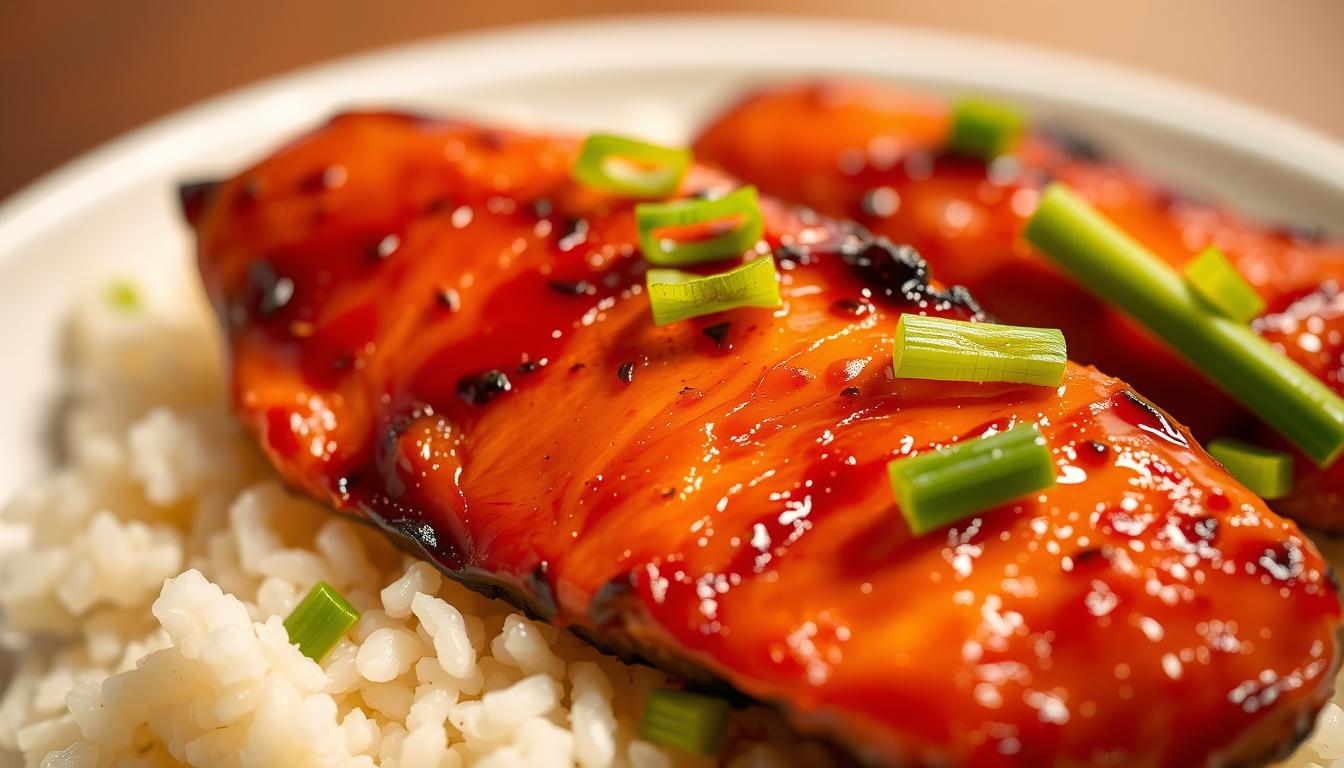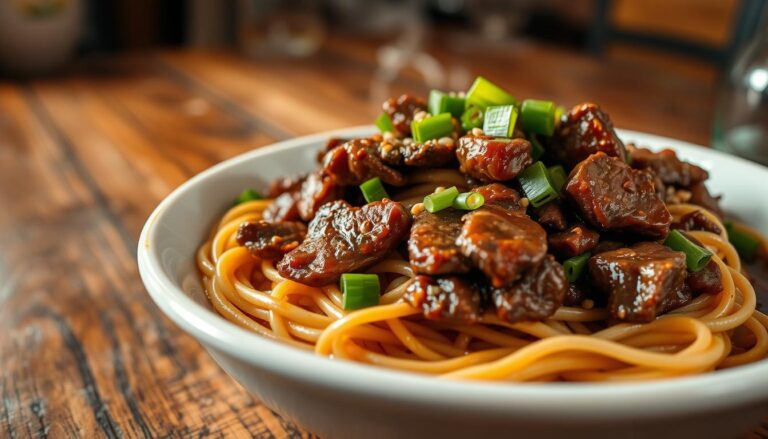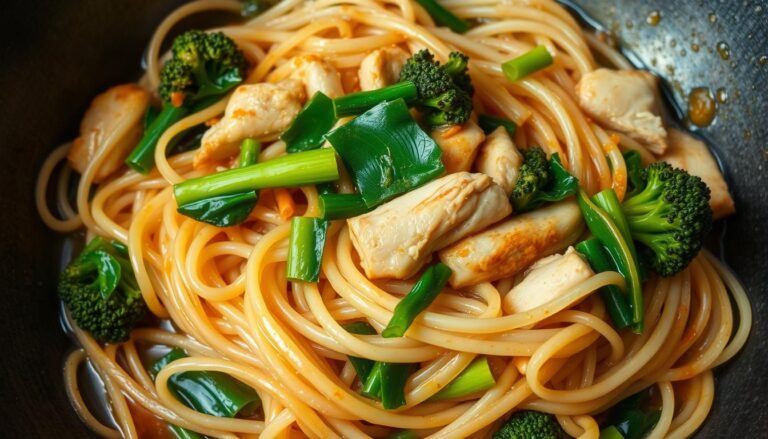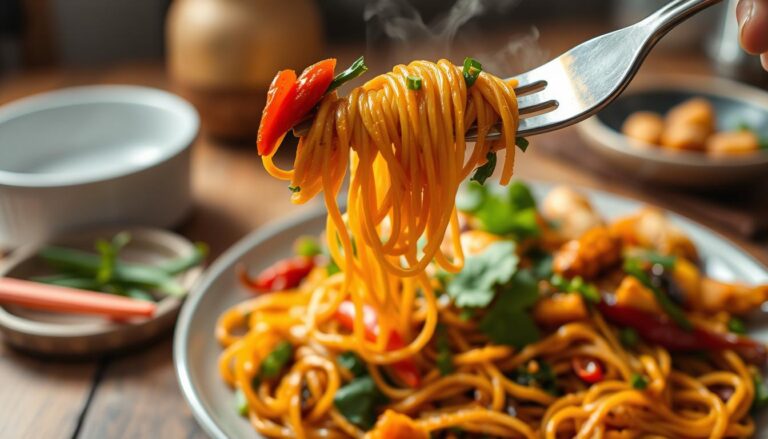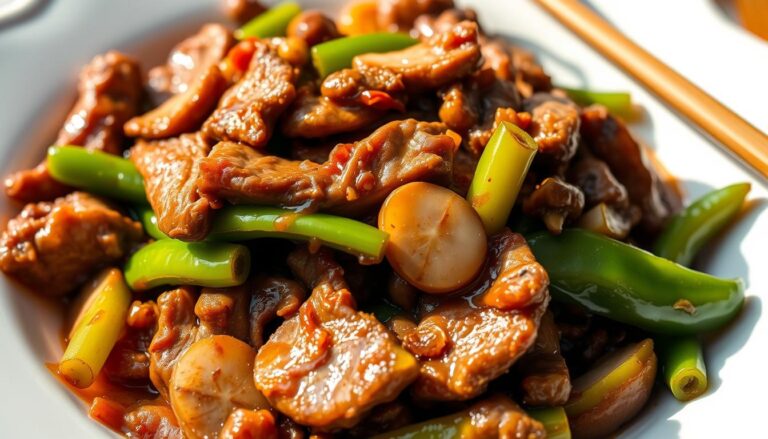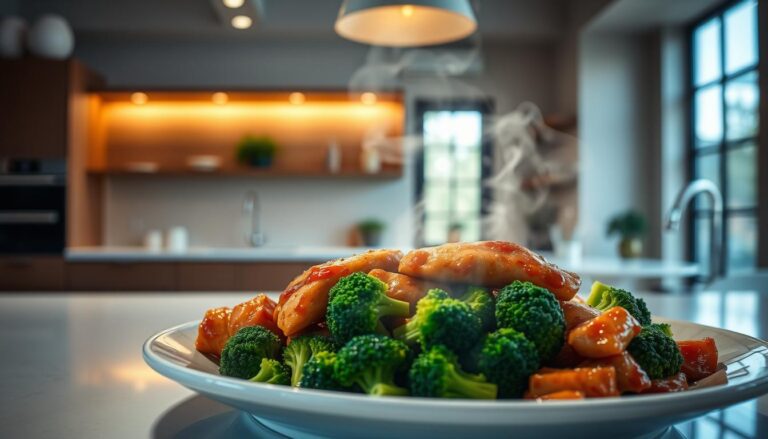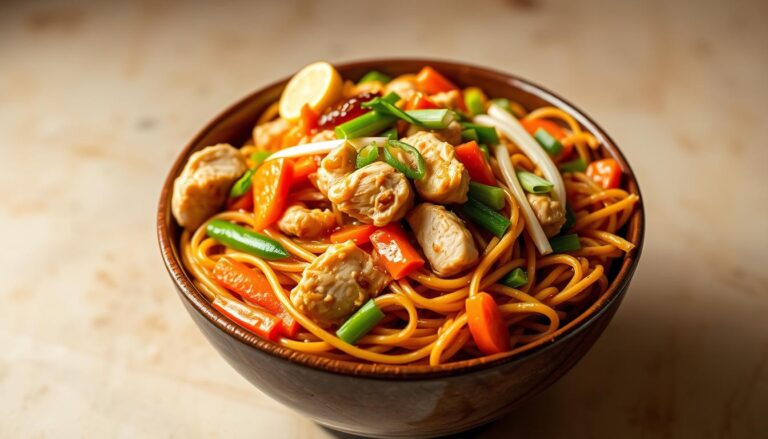How to Make Char-Siu Chicken | Easy Recipe Guide
Craving a flavorful dish that blends tradition with modern convenience? This char-siu-inspired recipe transforms the classic Cantonese barbecue staple into a quick, weeknight-friendly meal. Instead of pork, tender skinless chicken thighs soak up a sweet-savory glaze made with pantry staples like soy sauce, honey, and aromatic spices.
Originating from Chinese roasting techniques, char siu has evolved across cultures. Our version simplifies the process while honoring its roots. You’ll skip complicated steps without sacrificing depth of flavor. Whether using a grill pan or oven, the result is juicy, caramelized protein that pairs perfectly with rice or veggies.
This guide focuses on accessibility. No specialty stores or hours of marinating required. Even beginners can master the balance of tangy, smoky, and umami notes. Ready in under an hour, it’s ideal for busy schedules but impressive enough for gatherings.
Key Takeaways
- Adapts traditional Chinese barbecue methods for modern kitchens
- Uses skinless thighs for leaner, quicker cooking than pork
- Relies on common ingredients like soy sauce and honey
- Offers flexible cooking with grill pans or standard ovens
- Delivers restaurant-quality flavor in under 60 minutes
Overview and Inspiration
Imagine a dish born from ancient Chinese roasting pits, perfected over generations, now reimagined for today’s kitchens. This recipe’s roots stretch back to Cantonese barbecue traditions, where slow-roasted pork glazed with honey and spices became a street food staple. Vietnamese chefs later added their twist, balancing sweetness with tangy notes using ingredients like rice vinegar.
Cultural Background and Origins
Traditional char siu relied on pork belly or shoulder, marinated for hours in a mix of hoisin sauce, fermented bean paste, and five-spice powder—a blend of star anise, cloves, and cinnamon. The method spread across Asia, adapting to local tastes. In American homes, cooks swapped pork for skinless thighs, cutting cooking time while keeping meat juicy. This shift also reduced fat content without sacrificing flavor depth.
Modern Adaptations in American Kitchens
Today’s versions prioritize simplicity. Pantry staples like soy sauce and honey replace hard-to-find ingredients. Five-spice powder remains essential, adding warmth to the glaze. Home chefs use grill pans instead of specialized equipment, achieving that signature caramelized crust in minutes. Creative plating—like serving over rice noodles or in lettuce wraps—bridges tradition and innovation.
The sauce’s magic lies in its balance: hoisin sauce brings umami richness, while a hint of citrus brightens the profile. Thighs work best here—their higher fat content prevents drying during quick cooking. This approach honors history while fitting busy lifestyles.
Essential Ingredients and Marinade Tips
The foundation of great flavor lies in balancing sweet, salty, and savory elements. Your marinade acts as both tenderizer and flavor carrier, transforming simple ingredients into a complex taste experience. Let’s break down what makes this mixture work.
Key Marinade Ingredients & Their Roles
Soy sauce brings salty depth, while honey adds sweetness that caramelizes under heat. Garlic infuses aromatic warmth, and Chinese five-spice powder delivers earthy complexity with cinnamon and star anise. Hoisin sauce contributes umami richness, and a touch of ketchup balances acidity.
Marinating Times and Flavor Enhancers
For best results, let thighs soak for at least 30 minutes at room temperature. Overnight refrigeration deepens flavor penetration. To boost richness, add a teaspoon of sesame oil—its nutty notes complement the powder’s spices perfectly.
Preheat your pan on medium-high before cooking. This creates a sear that locks in juices while creating that signature char. If using an oven, baste every 10 minutes for even glazing. Adjust honey for sweetness or add chili flakes for heat—your kitchen, your rules.
Preparing and Trimming Chicken Thighs
Perfect execution starts long before heat touches the pan. Uniform thickness ensures every bite cooks evenly, whether you’re grilling or roasting. Let’s transform those irregular cuts into restaurant-worthy pieces ready for your marinade.
Butterflying for Even Cooking
Place thighs skin-side down on a cutting board. Run a sharp knife horizontally through the thickest part, stopping ½ inch from the edge. Open the meat like a book—this creates consistent ¾-inch thickness. Large pieces? Cut them into palm-sized portions after butterflying.
Chef Andrea Nguyen notes: “Uneven proteins lead to burnt edges and raw centers.” This technique works for most recipes, especially when using thicker ingredients like soy-based glazes. Pat pieces dry with paper towels first—moisture prevents caramelization.
Tips for Trimming and Uniform Thickness
Trim visible fat deposits with kitchen shears, leaving just enough for flavor. Press each thigh flat with your palm to identify uneven spots. For smaller cuts, skip butterflying—simply score the surface in a crisscross pattern to help marinade penetration.
Mix your glaze while prepping—combine 3 tablespoons soy sauce with 2 tablespoons honey for balanced sweetness. Allow 30 minutes marinating time minimum. Store extras in airtight containers for up to 3 days, perfect for quick weekday meals.
Remember: Consistent thickness = predictable cooking time. Whether using a grill pan or oven, this prep step guarantees juicy results every time.
Cooking Techniques for Char-Siu Chicken
Your kitchen setup determines how you’ll achieve that glossy caramelization. Each method offers distinct advantages, from smoky depth to hands-off convenience. Let’s explore three approaches to match your tools and time constraints.
Stovetop Grill Pan Mastery
Heat a heavy grill pan over medium-high until water droplets sizzle. Arrange thighs in a single layer—crowding steams meat instead of searing. Cook 5-6 minutes per side, brushing reserved marinade from a small bowl during the last 2 minutes. This builds layers of flavor while creating crispy edges.
Chef Ming Tsai advises: “Direct contact with ridges mimics traditional char marks.” Use tongs to rotate pieces 90 degrees halfway through for crosshatch patterns. Always check internal temperature—165°F ensures food safety without overcooking.
Oven vs. Charcoal Showdown
Oven roasting at 425°F offers set-and-forget ease. Place thighs on a rack over foil-lined sheet pan. Bake 18-22 minutes, basting twice. While convenient, this method lacks smoky nutrition benefits from live flames.
Charcoal grilling demands attention but delivers unmatched aroma. Bank coals to one side for indirect heat. Sear thighs directly over flames first, then move to cooler zones. The smoke infuses garlic and spices into every bite. Whichever method you choose, reserve some marinade for final glazing—it’s key to that sticky-sweet finish.
Serving Suggestions and Flavor Pairings
Transform your meal into a vibrant feast with these inspired serving ideas. The dish’s sweet-savory glaze pairs beautifully with both traditional and modern accompaniments, turning weeknight dinners into culinary adventures.
Traditional and Creative Presentation Ideas
Serve glazed thighs over steamed jasmine rice for a classic approach. The grains soak up extra sauce beautifully. For handheld meals, stuff tender pieces into fluffy bao buns with quick-pickled cucumbers. Add a teaspoon of hoisin sauce to the filling for extra richness.
Brighten your plate with a crunchy sesame-slaw: toss shredded cabbage with rice vinegar and a pinch of chili flakes. Creamy potato salad gets an Asian twist when mixed with sesame oil and scallions. Pickled daikon and carrots add tangy contrast to the caramelized glaze.
Each serving delivers 28g of protein while keeping carbs balanced. Garnish with toasted sesame seeds and cilantro sprigs for color contrast. Leftovers shine in banh mi sandwiches—layer meat on crusty rolls with jalapeños and sriracha mayo.
Repurpose extra thighs into fried rice: chop them finely and stir-fry with day-old grains. For spicy variations, add a teaspoon of chili oil to the pan. The marinade’s hoisin base also works as a dipping sauce when thinned with lime juice.
Adjust heat levels by serving with sliced Fresno peppers or mild cherry tomatoes. Experiment with peanut sauce for nutty depth—whisk 2 teaspoons of creamy butter into leftover glaze. Every adaptation keeps skinless chicken thighs versatile and exciting.
Additional Tips and Variations
Mastering this dish means knowing how to tweak it for any situation. Whether swapping cuts or boosting flavors, these pro tips ensure success across variations.
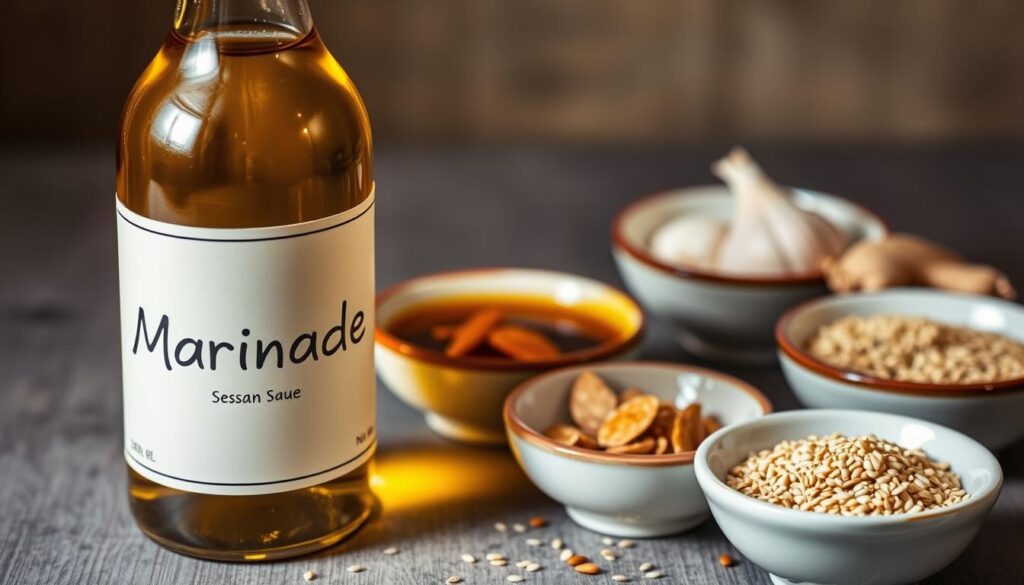
Adapting the Recipe for Different Chicken Cuts
Skinless chicken thighs work best, but tenderloins offer faster cooking. When using tenders, reduce cook time to 8-10 minutes. Always pat pieces dry with paper towels first—moisture prevents caramelization.
For bone-in cuts, extend cooking by 5-7 minutes. Chef Jet Tila advises: “Thinner cuts need higher heat for shorter periods to avoid toughness.” Adjust your pan temperature when you add chicken of varying thicknesses.
Enhancing the Marinade and Glazing Process
Boost flavor by whisking 1 tsp sesame oil into the marinade. Its nutty aroma complements sweet glazes. During the last minutes of cooking, baste frequently—this builds a glossy, sticky crust.
For intense color, mix ½ tsp cornstarch into reserved marinade before brushing. Want heat? Stir in chili crisp when you add chicken to the pan. Always use fresh paper towels to wipe excess marinade off surfaces for cleaner searing.
Glaze troubleshooting tip: If sugars burn, lower heat and add chicken back to the pan with 2 tbsp water. The steam helps loosen overcooked bits while keeping skinless chicken juicy.
Conclusion
Transform your weeknight dinners with a dish that’s as versatile as it is delicious. Start by prepping meat on a cutting board—trimming and butterflying ensures even cooking whether using the oven or grill. A 30-minute marinade locks in flavor, while basting creates that signature sticky glaze.
Pair leftovers with fried rice for an easy next-day meal. The recipe adapts effortlessly: swap sides, adjust spice levels, or try different cuts. Always pat chicken dry before cooking to maximize caramelization, and use your cutting board for precise portioning per serving.
Ready to impress? This method proves restaurant-quality results need no special skills. Share your twist using #WeeknightCharSiu and explore other global-inspired dishes. Your kitchen just became the tastiest classroom.
FAQ
Can I use a different protein instead of thighs?
Yes! Pork shoulder or tofu work well with the marinade. Adjust cooking times based on thickness to avoid drying out leaner cuts.
How long should I marinate the meat?
Aim for at least 2 hours, but overnight marinating maximizes flavor. For quicker results, let it sit at room temperature for 30 minutes before cooking.
What can I substitute for hoisin sauce?
Mix oyster sauce with a touch of honey or molasses. For a DIY version, blend soy sauce, peanut butter, and a pinch of five-spice powder.
Is a grill pan necessary for stovetop cooking?
No—a cast-iron skillet works too. Preheat it thoroughly to achieve caramelization, and flip the meat every few minutes for even charring.
How do I trim thighs for uniform thickness?
Remove excess fat with kitchen shears, then butterfly thicker portions. Pressing them flat with your palm before marinating ensures consistent cooking.
Can I make this gluten-free?
Absolutely. Use tamari instead of soy sauce and verify that your hoisin substitute (like coconut aminos) is certified gluten-free.
What sides pair best with this dish?
Serve with steamed jasmine rice, stir-fried bok choy, or tangy cucumber salad. For fusion meals, try stuffing it into tacos with pickled veggies.
How long do leftovers stay fresh?
Store cooked meat in an airtight container for up to 3 days. Reheat gently in a covered pan with a splash of water to retain moisture.
Can I freeze marinated thighs before cooking?
Yes. Freeze them in the marinade for up to 1 month. Thaw overnight in the fridge before grilling or roasting.

